Farm Newsletter
Sending love now, spinach in May
- On: March 21, 2020
 0
0
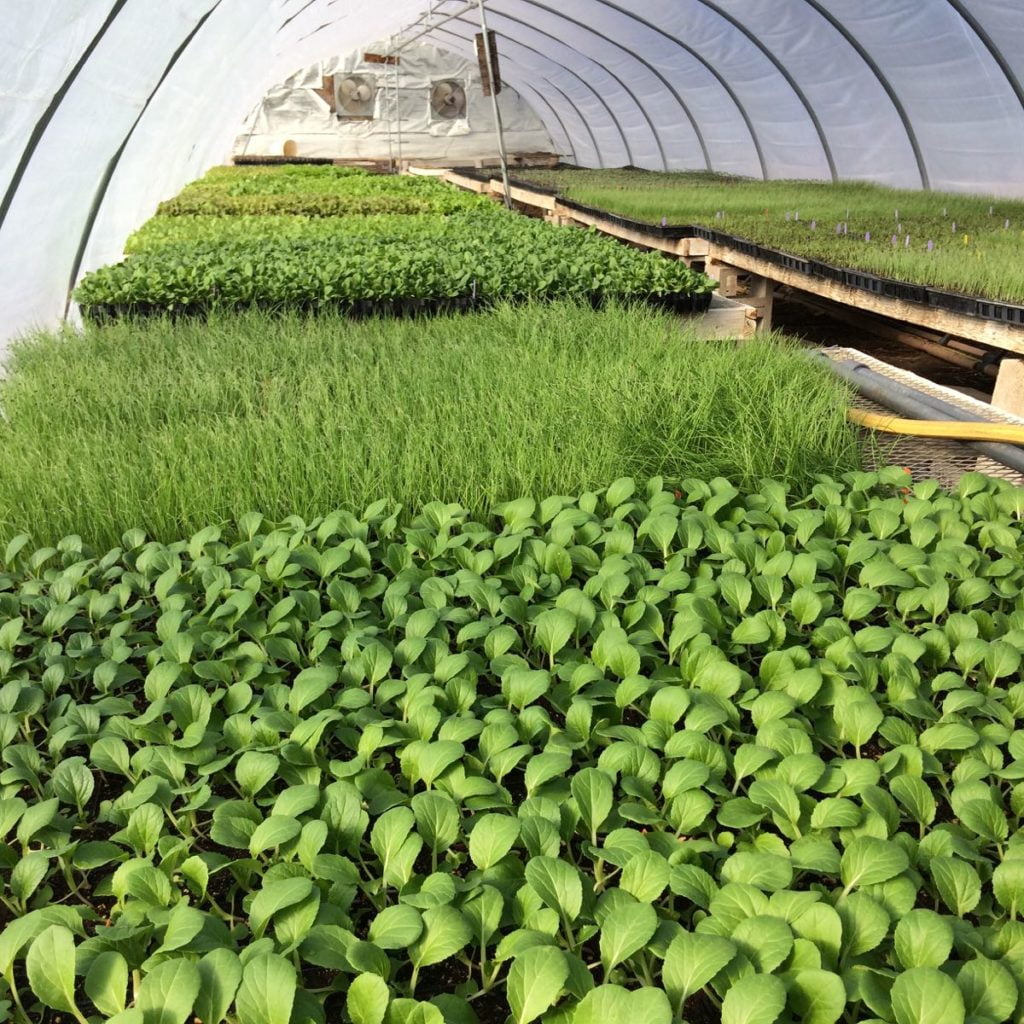
Greenhouse #1 is almost full with bok choy, scallions, onions, two plantings of lettuce and spinach, greens and more.
Here’s a message we sent to our members yesterday.
Hello folks,
We have been thinking about all of you, and hope you are safe and well during these scary times. Many of you have asked for CSA updates.
We are proceeding full speed ahead with the 2020 farming season. This is the most important work we can do right now. We expect to begin CSA deliveries in mid-to-late May, as usual, and will announce the delivery schedule in early May.
We have spent the last few years developing our food safety program, so we’ve thought about (and prepared for) how to keep the farm clean and disinfected. We are closely following the CDC’s information, and will adapt our deliveries to match their recommendations. We’ve got two months to hammer out the details. We’ll keep you posted as we determine what changes are needed.
In the meantime, our greenhouses are filling and the perennial crops are awakening outdoors. We hope you can find a bit of peace in knowing that local food will be available. We’ll be thinking of all of you, and hope you stay healthy. Feel free to contact us if you have questions of any kind.
Beth and Steve
Storage Share, Nov. 21/22, 2019
- On: November 20, 2019
 0
0
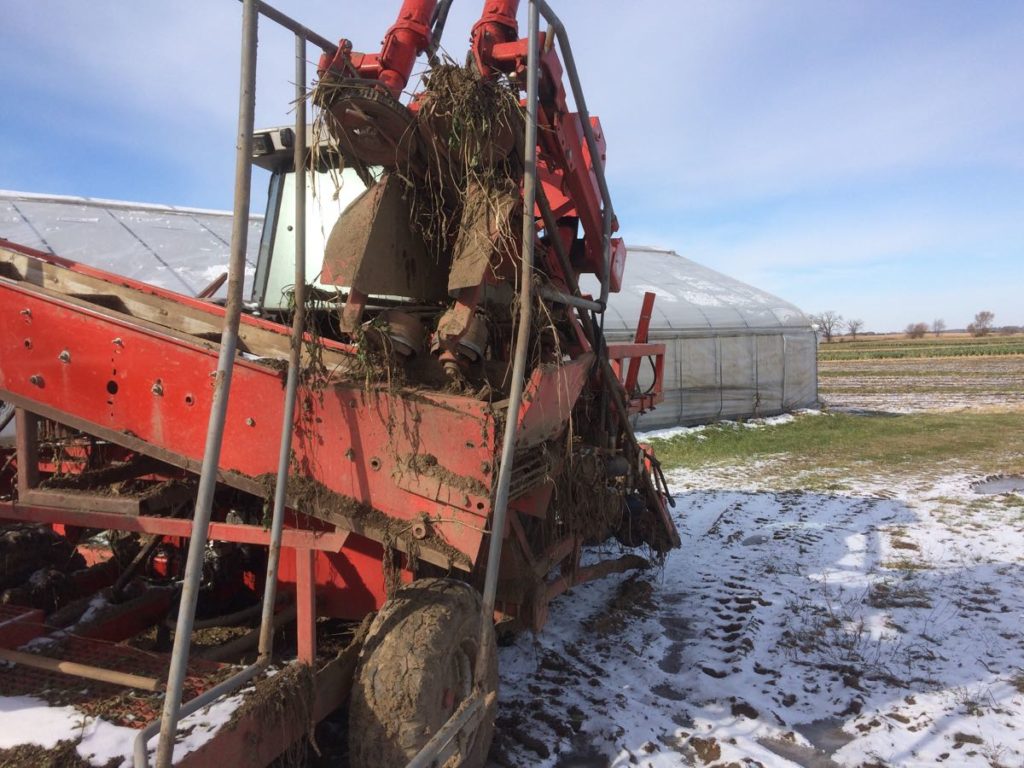
We ended the season with all our equipment covered in mud, including this very muddy carrot harvester.
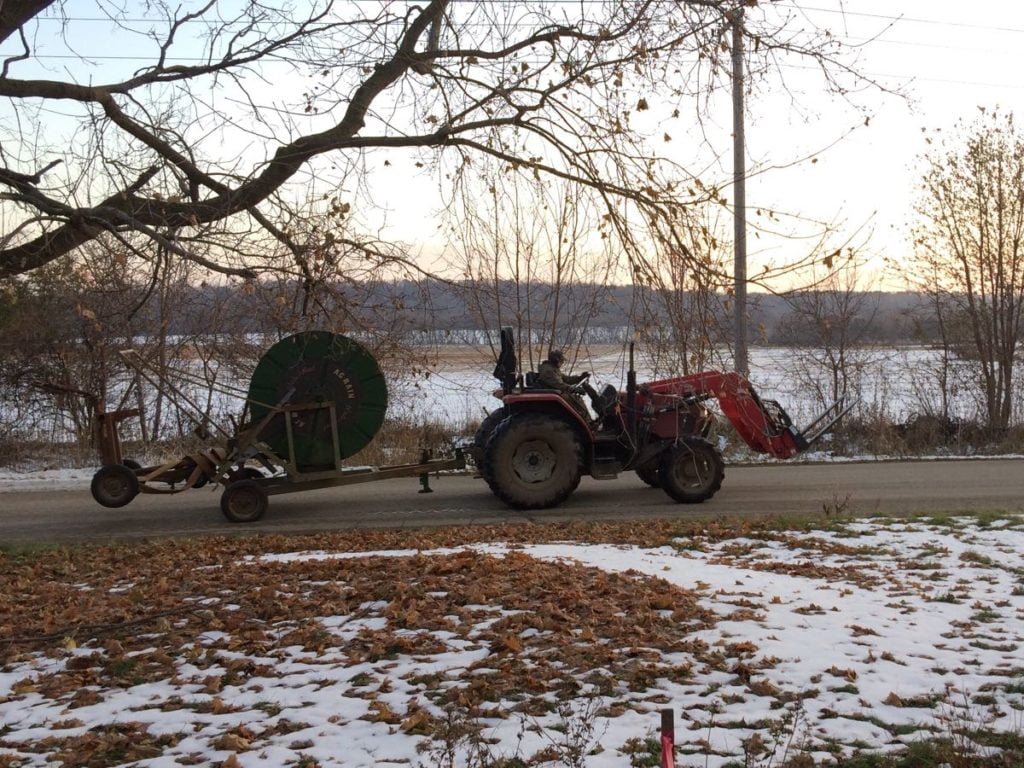
Steve takes our irrigator to overwinter in the neighbor’s shed. It didn’t get much use this year.
Our season is DONE. Often, we’re still harvesting in November but the cold weather ended our outdoor work. We are very grateful for the recent warm-up. It makes everything easier, including getting this Storage Share ready. The warmer weather has given us a chance to clean equipment before putting it away in storage until spring. We worried that we’d have to put everything away covered in mud.
Now we look forward to winter, with lots of cooking, ice skating and skiing (we hope!) before planning next season. Have a wonderful Thanksgiving! Beth & Steve
Storage Share this week
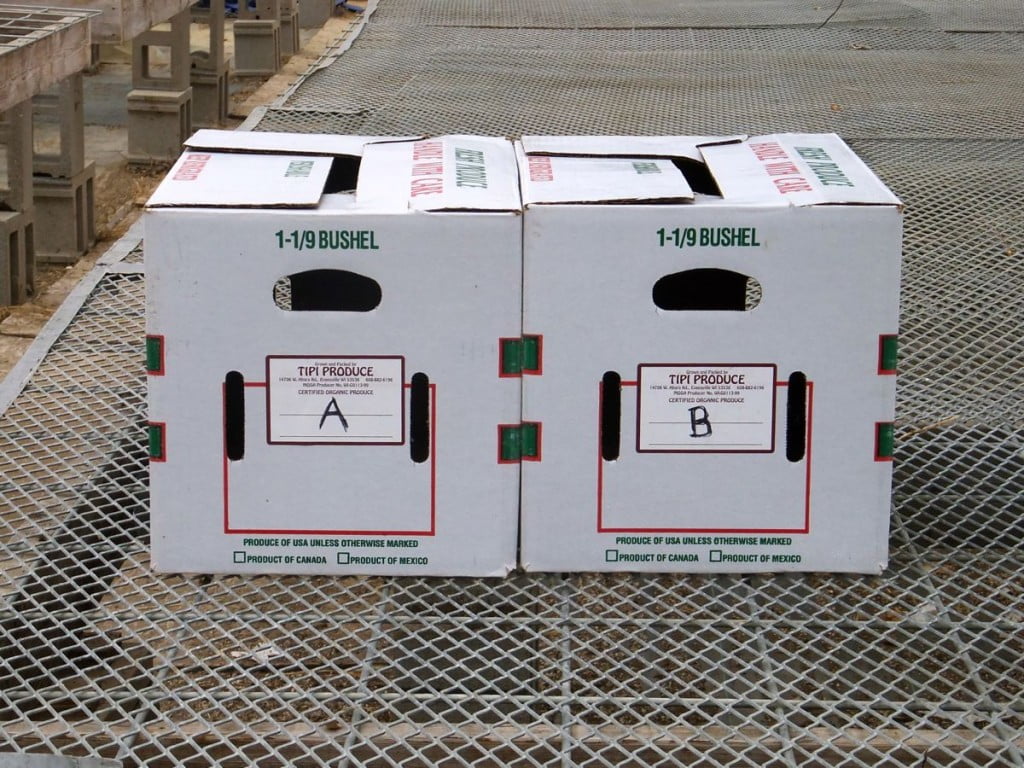
Take one box labelled “A” and one box labelled “B”.
Things you need to know about your winter share
* Your delivery will consist of two different boxes, labeled “A” and “B”. Take one “A” box and one “B” box. The boxes contain different vegetables.
* Please pick up your boxes on the day of delivery, during the normal hours for your site.
* Outpost members, pick up your boxes on Friday. This is the busiest weekend of the year for the Outpost staff, so they WILL NOT hold boxes past Friday, nor can they handle special requests.
* Members at unheated sites, please replace the blankets carefully. That keeps everyone’s produce in good shape.
* Bring lots of bags to take your produce home. It’s a lot of produce!
Veggie List and Storage Info (Storage share, Nov. 21/22, 2019)
We hope you enjoy this shipment of veggies. Strategize to use them well, as some will last longer than others.
* These are the most perishable vegetables: kale, the green parts of the leeks
* These are the next-most perishable: Brussels sprouts, cabbage, the white parts of the leeks, and onions. Keep an eye on your butternut, potatoes and sweet potatoes. The last two are susceptible to drying out. Expect the largest butternuts to last the longest.
* These will last the longest: daikon radish, beets, carrots, celeriac, garlic, parsnips.
Box “A”
Refrigerate everything in this box.
Beets, 3 lb
Brussels sprouts, on stalks
Carrots, 6 lb total
….. orange ~4 lb
….. yellow & purple ~2 lb
Celeriac, 1
Daikon winter radishes, several
Green cabbage, 1 medium or 2 small
Kale “garnish”
Leeks, ~3 lb
Parsnips, ~3 lb
Box “B”
The Brussels sprouts need refrigeration. Everything else in this box can be stored cool or at room temperature. See notes below for more detail.
One more Brussels sprouts stalk
Butternut squash, 9 – 10 lb
Garlic, 3 bulbs
Onions, 5 lb total
….. ~1 lb red
….. ~4 lb yellow
Potatoes, russet, 5 lb
Potatoes, Satina, 5 lb
Shallots, 2
Sweet potatoes, ~10 lb
Beets – Refrigerate in a bag or container. Beets will store for two months or longer.
Brussels sprouts – Pluck from stalks and refrigerate in a bag or container. Do this the day you pick up your CSA boxes. Eat within 2 to 3 weeks.
Butternut winter squash – You will receive ~9 lbs of squash. Store your butternut in a cool, dry place. 60 F is ideal. Do not put in a plastic bag. Expect the largest butternuts to store the longest. Inspect your squash frequently and cook promptly if you see any soft spots developing. You can cook, mash and freeze the squash for future use. I find that you can refrigerate cut raw squash for up to one week. This runs counter to the accepted way to store squash, but is useful if you want to cook just half a squash. Try microwaving your squash for one to two minutes before cutting or peeling. This softens the squash and makes a large butternut easier to handle.
Cabbage – Refrigerate.
Carrots, orange. Refrigerate in a plastic bag. Will keep for several weeks.
Carrots, yellow & purple. These varieties are pretty AND they taste good.
Celeriac – Will store for months in your fridge. Cut off chunks as needed. Peel before using. I find it easiest to cut the celeriac into flat slices, then peel.
Daikon radishes (oblong, white or purple) – Refrigerate. The interior color of the purple ones is lovely. Slice thinly and add to salads, cook lightly in mixed vegetable medleys or cut into matchsticks and add to pasta salads. We enjoy grated carrot and daikon salads all winter.
Garlic – Store at room temperature.
Kale – It is tiny. We rarely send something so small. However, that was the last thing our crew harvested on a cold, dim, muddy day. They were so proud of what they accomplished that now we have to use it. Tuck it in a dish or use it as a garnish. The crew brainstormed and they think it would make a great corsage for the Thanksgiving cook in your household. Storage: Refrigerate and use soon.
Leeks. The bottoms (white part) will store longer than the tops (green and pale-green parts). We suggest that you cut off and use the tops first. It’s unconventional but you’ll be able to store the bottoms for longer. In general, leeks are not a long-storage crop. You may need to strip off one or two outer leaves to freshen the leeks before you cook them.
Onions: Refrigerate or store in a cool, dark spot and protect from light. Exposure to light stimulates sprouting. If you have the room, it’s safer to store the onions in the refrigerator. After the wet fall, they might not last as long as usual.
Parsnips (These look like large white carrots.) – Refrigerate in a plastic bag. Parsnips will store for several months but will darken in color. That is a harmless change.
Potatoes; russets and Satinas – Can be stored at room temperature or in a cool spot, but must be kept in the dark so they do not turn green. A cloth or loose plastic bag draped over the paper bag will slow moisture loss, but do not close the plastic bag. Both types will store longer if kept cool. Around 40 – 50 F is ideal. The potatoes were grown by the Igl family near Antigo.
Russets– We got the big ‘baking’ grade so you have nice bakers for Thanksgiving. Excellent for baked or mashed potatoes.
Satinas– These are good all-purpose potatoes, everything from roasted to potato salad. I really like this variety of yellow potato because they oven-roast so well and because they are less sweet than other yellow varieties such as Yukon Golds.
Shallots (look like small red onions) – Good for salad dressing.
Sweet potatoes – These are the Covington variety, with excellent flavor and sweetness. Store at room temperature, no lower than 55 F, but 60+ F is better. Keep them on your kitchen counter where it’s easy to keep an eye on them. I like to keep ours in a paper bag so they don’t dehydrate. Cook promptly if they start to soften. The roots come in a wide ranges of sizes and all are good.
Recipe Ideas
I will not try to sway your Thanksgiving menus. I bet you have your dishes chosen, perhaps based on family tradition. However, this is a great time of year to gather recipes to enjoy all winter. You should peruse online cooking sites while they are feature Thanksgiving menus, many of which are suited to your Storage share vegetables. Bookmark the recipes soon; Thanksgiving collections are taken down quickly after the holiday. I have a huge list of recipes bookmarked to delve into this winter.
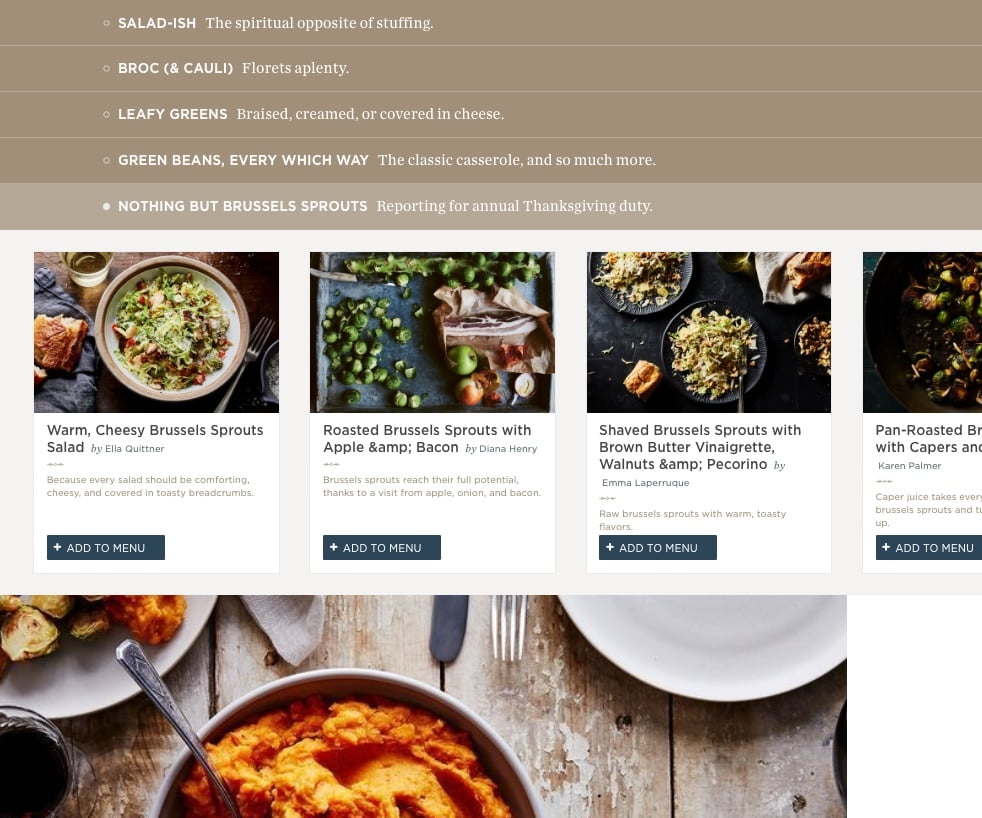
One small corner of Food52’s Thanksgiving Menu Maker.
♦ Once again, the lively Food52.com site has outdone itself with a fantastic Thanksgiving recipe collection. They call it their “AutoMagic Thanksgiving Menu Maker“. It’s organized by type of dish, e.g.
. “Gratins; Lots of creamy layers,” and
. “Veggie Packed Stuffing; Bring on the fall bounty”, and
. “Nothing but Brussels sprouts; Reporting for Thanksgiving Duty.”
Section #6 (“Orange Sides”) is extensive. I’m gathering a suite of recipes to try this winter. First stop will be “The Absolute Best—& Worst—Way to Make Mashed Potatoes, According to So Many Tests.” The tag line is “I spent 14 hours alone with only potatoes, and I did it for you.” Yes, they are amusing.
♦ Smitten Kitchen is our go-to site for dessert recipes but has excellent veggie recipes too. You can follow her Thanksgiving preparations or go straight to an amazing list of Thanksgiving recipes from previous years. I’m itching to try her Roasted Cabbage with Walnuts and Parmesan recipe.
♦ The Dishing Up the Dirt site doesn’t have a specific Thanksgiving section, but many of her recipes are tailored to Storage share produce.
♦ Halfbaked Harvest has appealing dinner and salad ideas, and gorgeous food photos.
♦ Finally, remember that we can use Local Thyme recipes all winter. Check them out for Thanksgiving ideas.
Extension Share, Nov. 7/8, 2019
- On: November 06, 2019
 0
0
Extension Share
This is a stand-alone share, for those who registered. Our regular CSA season ended last week.
Mad dash
Folks, this is insane weather. Take a look at the forecast. Monday night is projected to be 8 degrees, followed by a string of nights almost as cold. We had no choice; in the last 10 days, we have sprinted through a month of harvests. It looked like Tuesday would be our last possible harvest. The day ended with almost all crops gathered except a field of parsnips still in the ground. That tainted our relief at getting almost everything finished. Then we got a reprieve! This morning’s snow skipped us, so Steve, Maggie and a few others got the harvester out and dug the parsnips. It was cold and windy but had to be done. The tractor and harvester ended the day completely covered in mud. Hopefully there will be a warm day to clean them before storing for winter.
Our field work is done. We are tired and our crew is tired, but we are thrilled to grub our way to the end of the field season. Thank you for being Tipi members this year! Beth & Steve
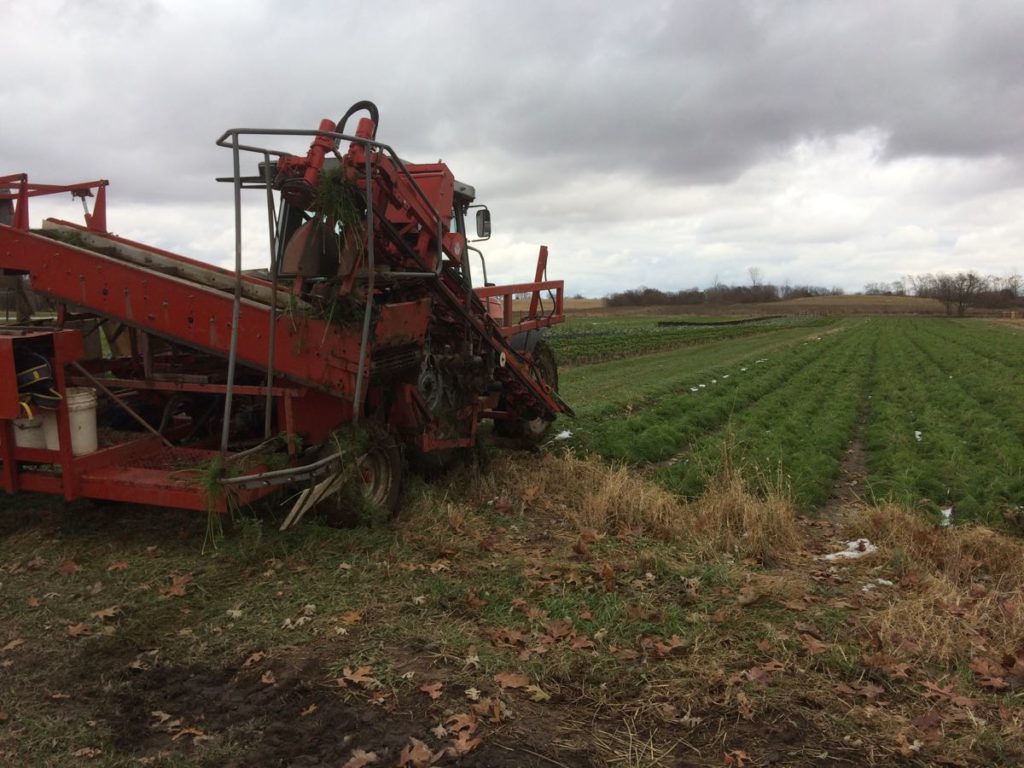
Weekend warriors. Steve and I spent the entire weekend harvesting carrots. Do you see the patches of snow between the carrot rows? We could not waste the weekend days.
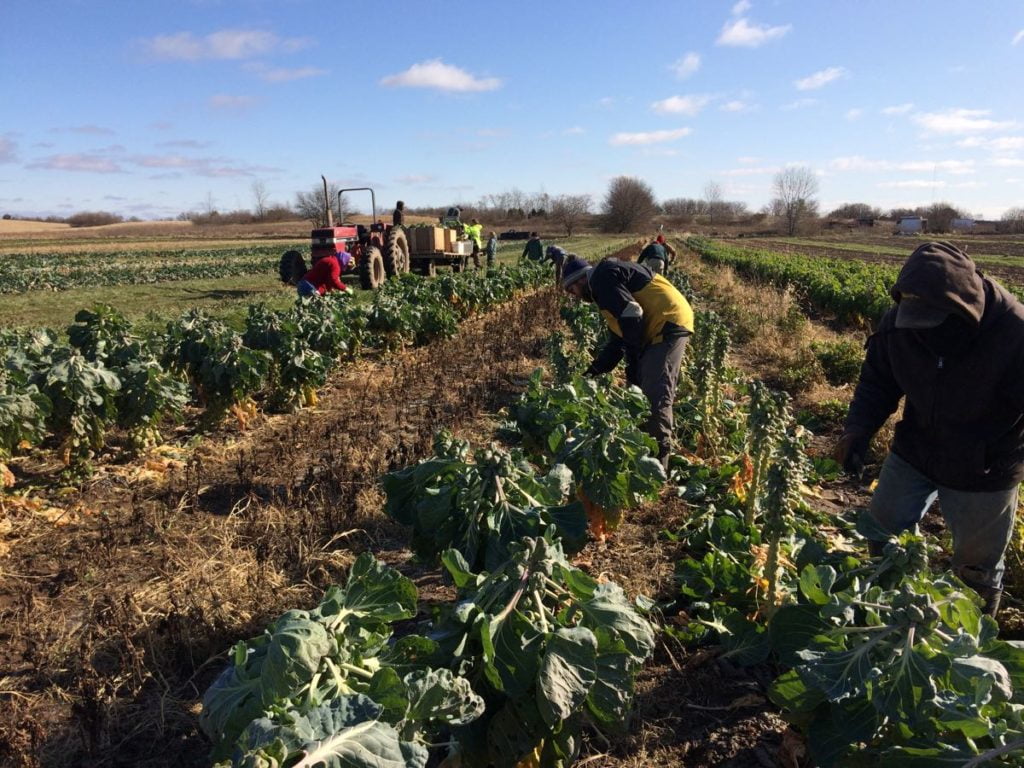
Only the most cold-hardy crops were still in the field on Tuesday. We made a mad dash through the Brussels sprouts field, cutting and piling stalks into bins. We worked indoors today to pluck the sprouts from the stalks.
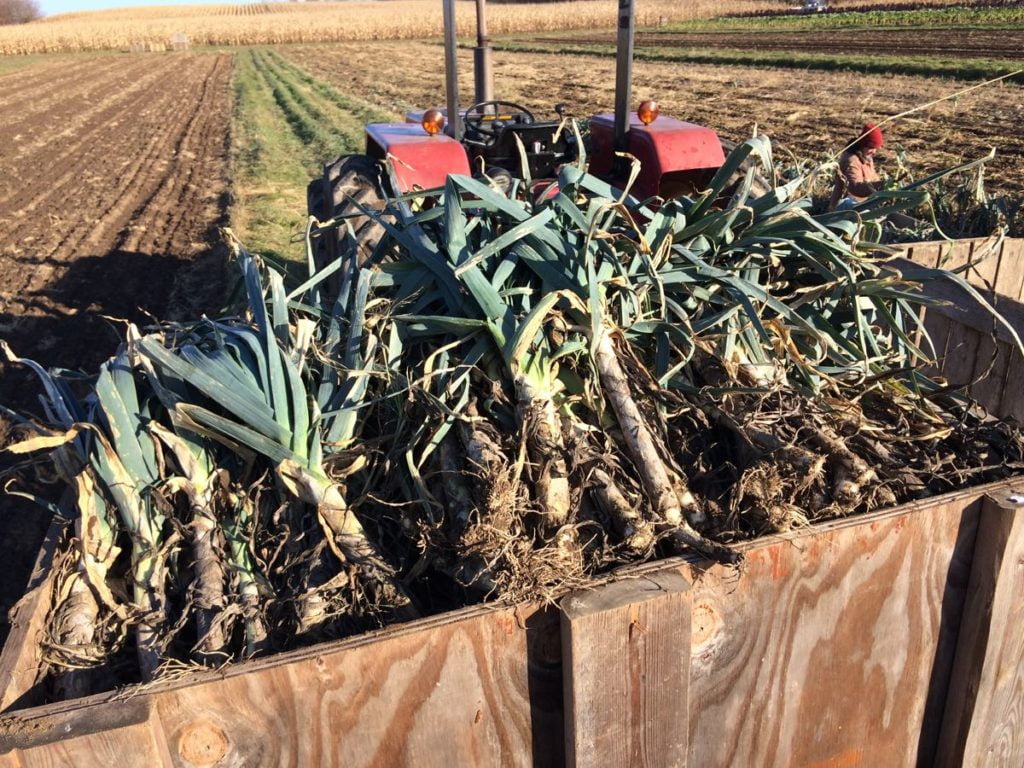
We filled bins with leeks too, then brought them back to the buildings to clean up.
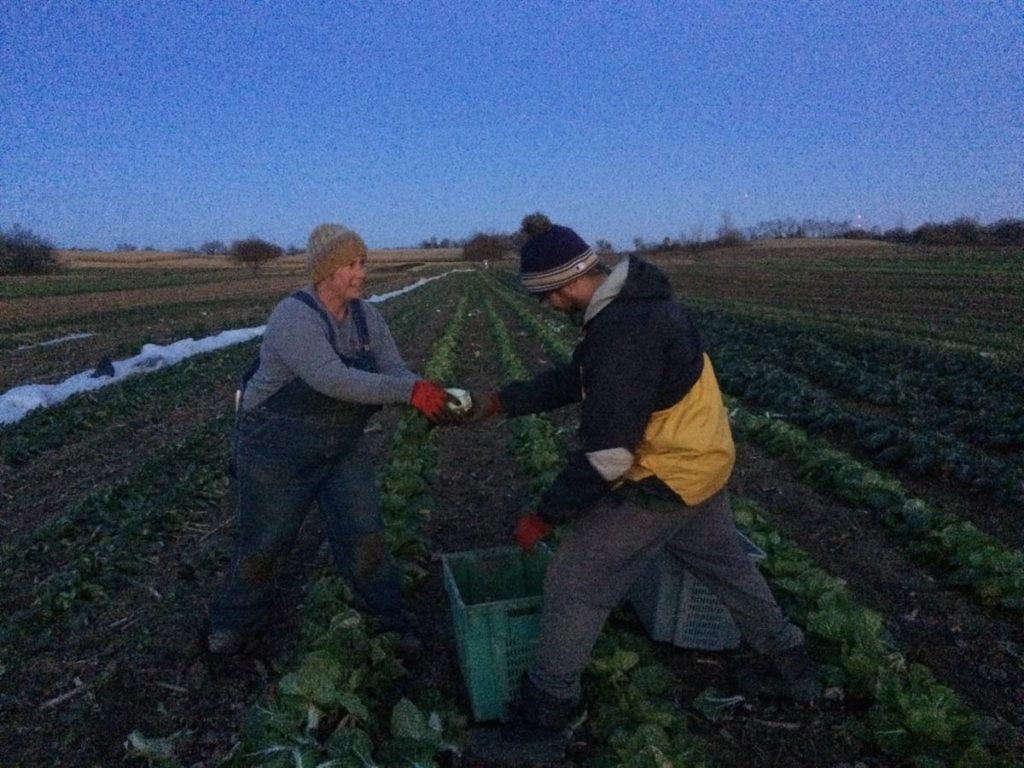
At dusk, Maggie and John raced to harvest the last napa cabbage.
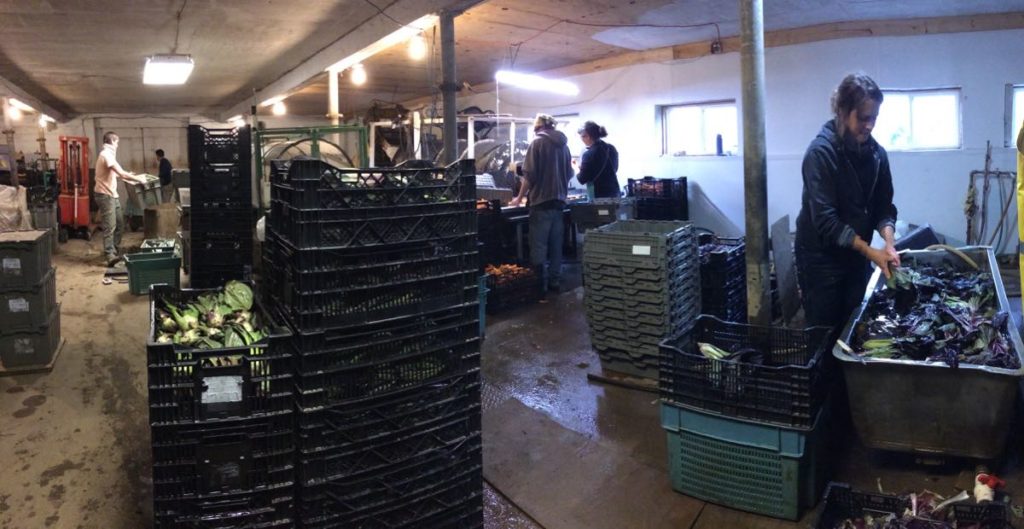
Today, we squeezed into our indoor heated space to prepare this week’s produce. It’s much smaller than our unheated pack shed and felt pretty crowded. From left, Billy and Jory prepare leeks, Smitty and Kristin wash carrots, and Karen washed bok choy.
Extension Share Veggie List
Red cabbage
Mixed fall greens, probably
– red bok choy, plus
– red mizuna, plus
– tatsoi.
‘Metro’ butternut squash
Sweet potatoes, ~3 lb
Brussels sprouts, ~ 1 lb
Carrots, 2 lb
Leeks, 1 – 1.25 lb
Yellow onion
A few items need extra washing.
The cold weather forced us into smaller quarters indoors. Your butternut squash, leeks and sweet potatoes are more lightly washed than usual, and will need a little extra attention from you. It’s the best we could do!
Mixed fall greens – We’re sending several small heads in the choy family. They’ll be good mixed together. The tat soi and the red choy have some silvering on the leaves, from being protected under row cover on cold nights.
RECIPES
Visit our 2019 Recipe Log or our 2018 Recipe Log or join our Facebook discussion group.
LOCAL THYME/ Comforting Classics
Brussels Sprouts with Lemon and Almonds
Red Cabbage and Brussels Sprout Slaw with Honey Poppy Seed Dressing
Black Eyed Peas and Greens Soup
Beef, Leek and Sweet Potato All-Day Stew
LOCAL THYME/ Outside the Box Recipes
Glass Noodles with Shredded Veggies and Sweet Chili Sauce
Braised Red Cabbage With Apples, Bacon and Wine
Miso Braised Chicken with Sweet Potato and Greens
Black Bean Burrito with Chipotle Sweet Potatoes and Red Cabbage
LOCAL THYME/ Quick & Easy Meal
Smoked Trout Salad on a Bed of Shredded Cabbage
????????????
RECIPES FROM LAUREN
BRUSSELS SPROUTS, PICKLED CARROTS & WINTER GREENS
Adapted from Six Seasons
Serves 2-4
Takes 1 hour
1 pound carrots, cut very thin on the diagonal
1 cup apple cider vinegar
1/2 cup water
1/2 cup sugar
2 tablespoons + 1 teaspoon Kosher salt, divided
1 tablespoon black peppercorns
1 tablespoon mustard seed
1 pound Brussels sprouts
1/4 cup olive oil, plus more for drizzling
1/4 teaspoon freshly ground black pepper
1/2 yellow onion, thinly sliced
1/4 cup honey
1/3 cup champagne vinegar
Pinch red pepper flakes
2 garlic cloves, minced
3 tablespoons butter
1 head mizuna, thinly sliced
1 head tatsoi, greens onion, thinly sliced
1 cup toasted walnuts, roughly chopped
- Preheat oven to 450 degrees.
- Place carrots in a small glass bowl.
- In a medium saucepan, combine vinegar, water, sugar, 2 tablespoons salt, peppercorns and mustard seed. Bring to a boil and then pour immediately over carrots. Set aside to quick pickle while you prepare the rest of the dish.
- Toss Brussels sprouts with olive oil, 1 teaspoon salt and pepper. Roast for 20-25 minutes until crisp all over. Place in large bowl with yellow onion.
- Meanwhile, heat honey in a small saucepan over medium low heat until it turns golden. Remove from heat and whisk in vinegar, red pepper flakes and garlic until smooth. Return to medium low heat and add butter, 1 tablespoon at a time, whisking until it melts. Let simmer 2-3 minutes more, stirring occasionally. Pour over Brussels and onions while still warm.
- Just before serving toss roasted veggies with greens, walnuts and half of the pickled carrots (store the rest in your fridge for up to 3 weeks). If the salad is too acidic, add a drizzle or two of olive oil.
.
????????????
.
FALL HARVEST RISOTTO
Takes 1 hour
Serves 6-8
4 tablespoons butter
2 large leeks, white and light green parts only, sliced in half lengthwise and sliced
1/2 large yellow onion, diced
2 cups peeled sweet potatoes, diced
3 cups butternut squash, peeled and diced
1 cup arborio rice
1/4 cup white wine
6 cups chicken broth
1/2 teaspoon dried sage
Kosher salt & freshly ground black pepper
- Melt butter in a large stockpot over medium heat. Add leeks and onions, along with a couple pinches of salt and pepper. Cook for 10 minutes.
- Reduce heat to medium low. Add potatoes, butternut squash and a few more pinches of salt and pepper. Cook for 15 minutes until soft, stirring every couple minutes. The bottom of the pan may brown a little, but don’t worry about this. It will just add flavor!
- In a separate large sauce pan, bring broth to a low simmer.
- Add rice and stir to combine. Stir for a couple minutes to toast the rice. Add wine and use a wooden spoon to scrape any browned bits off the bottom of the pan.
- Use a ladle to add a couple spoonfuls of simmering broth to the stockpot. Stir to combine and continue stirring every minute or so to keep it from sticking to the bottom of the pan. The idea is to stir it often enough that it has no chance to stick, but not so frequently that it doesn’t have a chance to simmer. Add sage after first addition of broth. Continue adding ladlefuls of stock every few minutes. You will keep adding and stirring and adding and stirring (slowly) for 30-35 minutes. Taste occasionally to test the texture of the rice. You want it to be cooked but not too mushy at the end. Adjust seasonings as desired.
Week #24; Final delivery of the regular season!
- On: October 30, 2019
 0
0
Thank you!
Folks, this is the final delivery of our regular CSA season. Thank you for joining our farming adventure this year! We could not farm without the support of you, our community of eaters. We hope you enjoyed the produce, the newsletters and recipes, and the farm events.
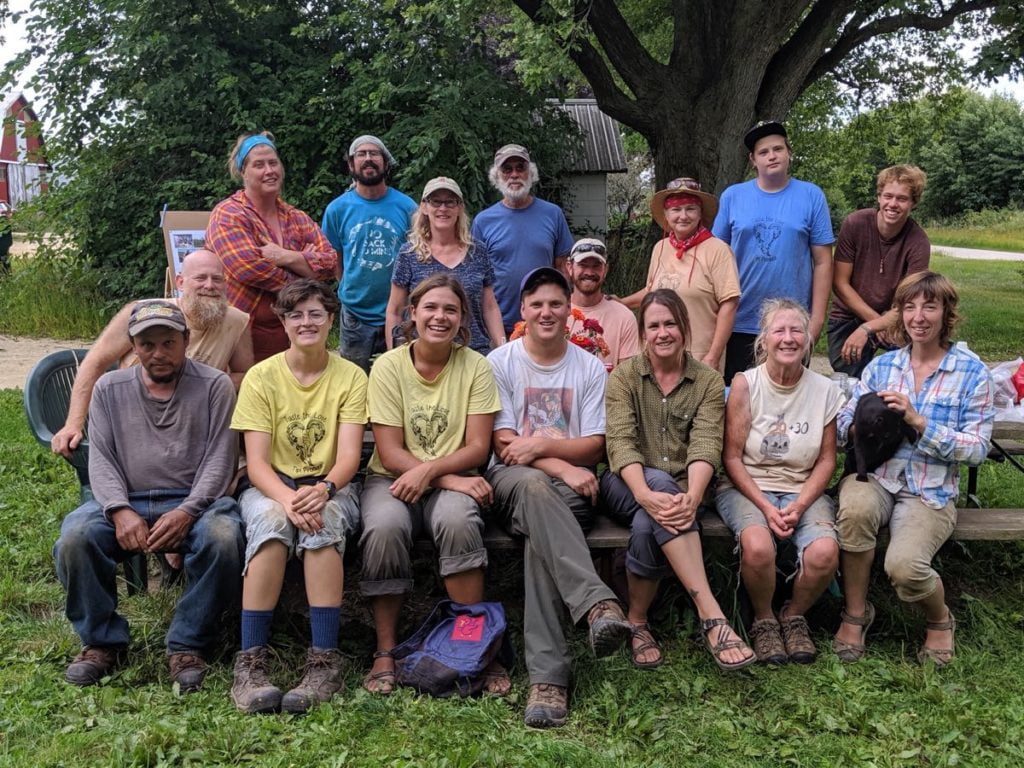
All your farmers thank you. From left, back row; Ben (seated), Maggie, Smitty, Beth, Steve, Billy (seated), Linda, Chance and Michio. Front row; Raul, Monika, Anna, Jory, Karen, Simone, Kerry. MIA Alex, David, Jim, John, Josh, Kristin and the high school crew.
What a week
I often reflect on the season for this final newsletter. Not this year. The cold snap and coming snow forced us to hustle to bring in frost-sensitive crops, and to get garlic planted for next year. It’s been quite a week. After the snow melts, it will take another week or two to finish harvesting our root crops. We don’t like leaving them in the field in such cold weather but the roots are snug in the still-warm soil and the tops will (hopefully) remain strong enough to pull with our harvesting equipment. A blanket of snow will insulate the carrots but make a muddy harvest next week.
Soon, we will be done for the season. This year has taken a lot of effort, and we look forward to our winter rest. By January, we’ll have our plans finalized and will start ordering seeds. By late February, the greenhouse will be running and seeds sprouting. We hope most of you will join us again next season. We’ll be in touch this winter.
Beth and Steve
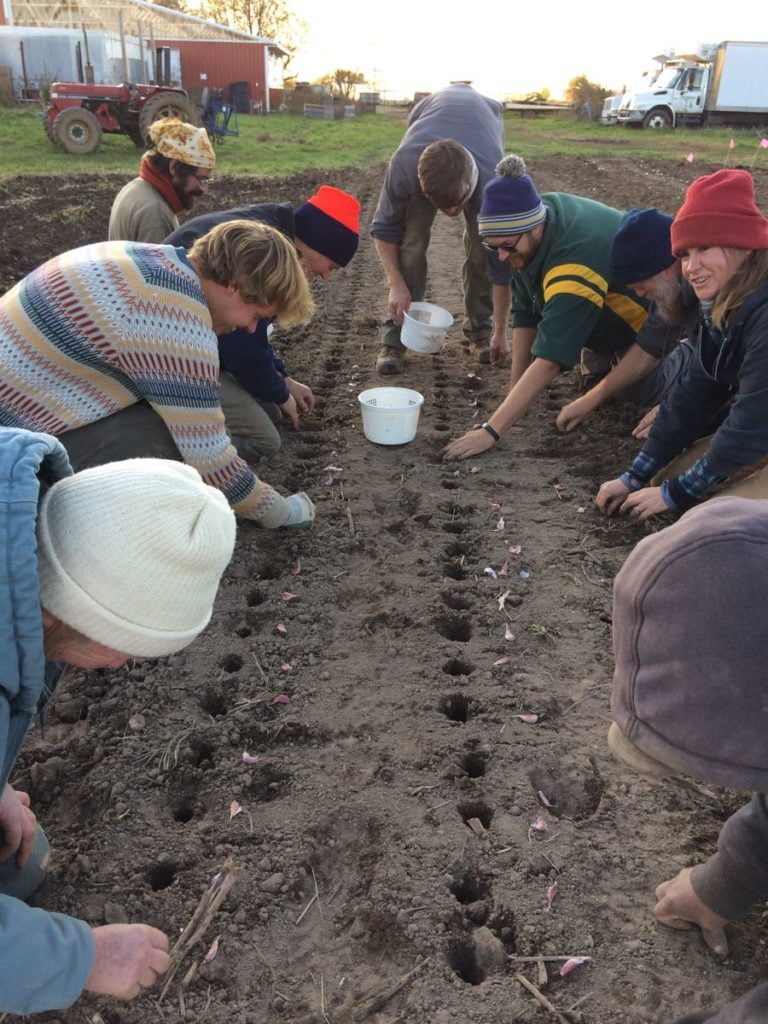
We planted garlic on Friday, before the weather turned wintery. You really need dry soil for this job. We rarely work in such a tight cluster but were at the end of the row and everyone was having fun together.
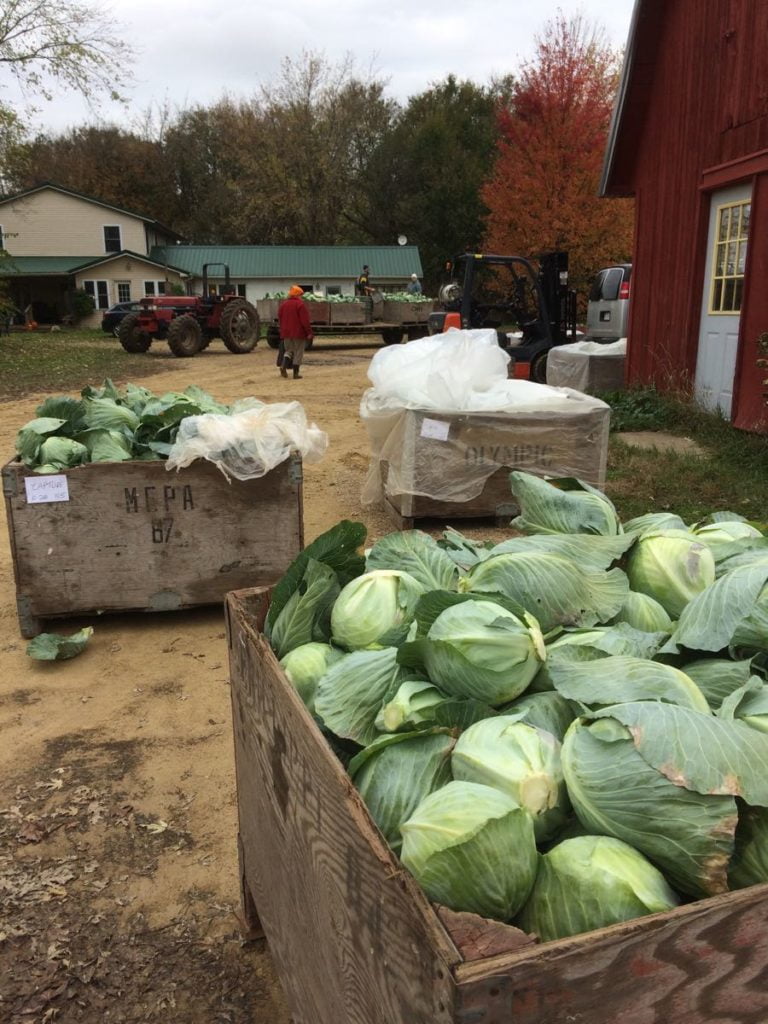
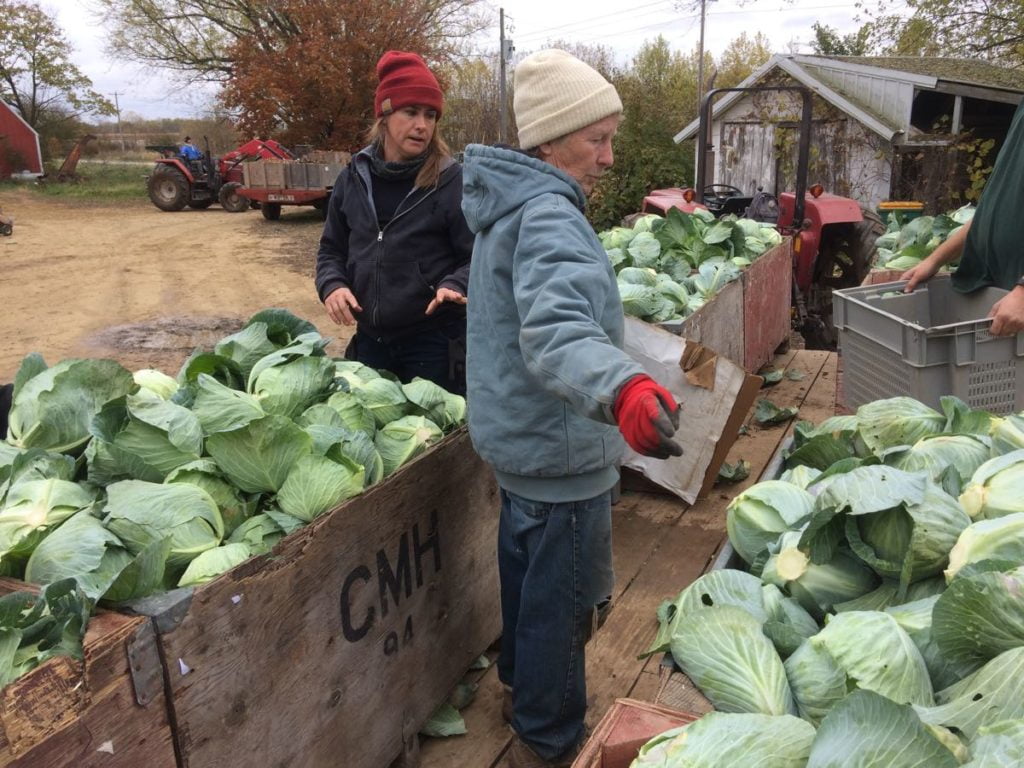
Cabbage is a very important crop for us, something we’ll store and sell through the winter. However, it won’t survive the low temperatures predicted for tomorrow night so we raced to get it all out of the fields. It’s taken a full week. Simone (blue coat) manages our cabbage crop. Above, she and Karen (red hat) make sure that all the varieties are kept separate.
We were simultaneously harvesting carrots with a separate crew. You can see Billy unloading bins of carrots in the background.
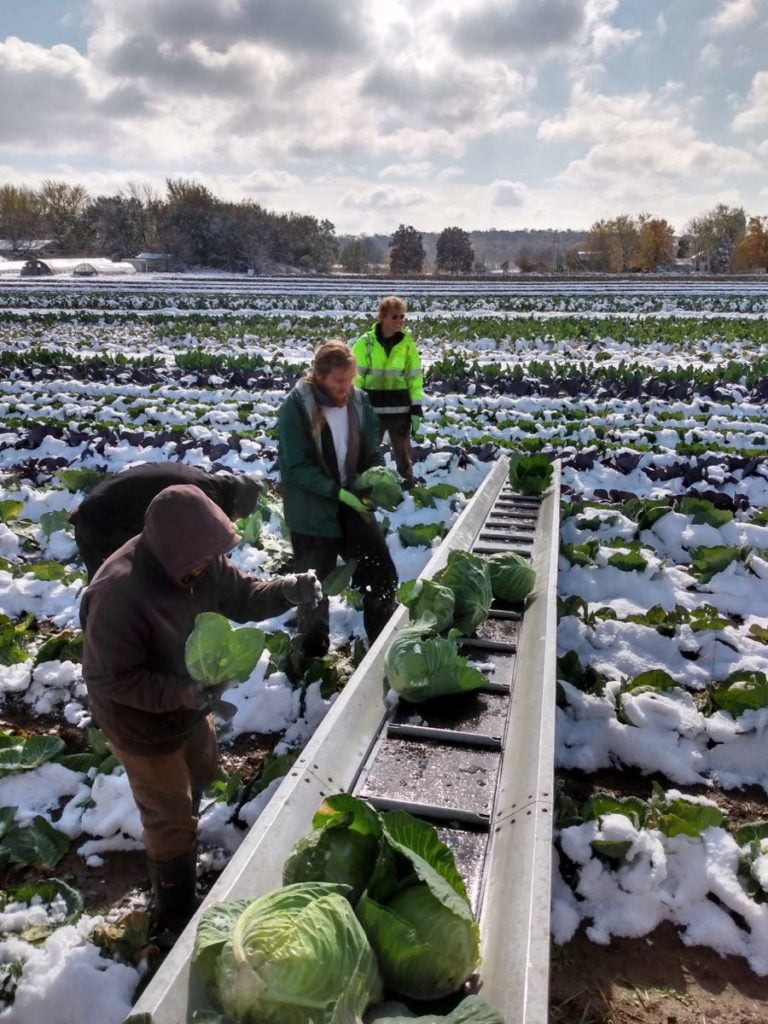
We couldn’t wait for the snow to melt to continue the cabbage harvest. Photo credit, Karen Nicholson
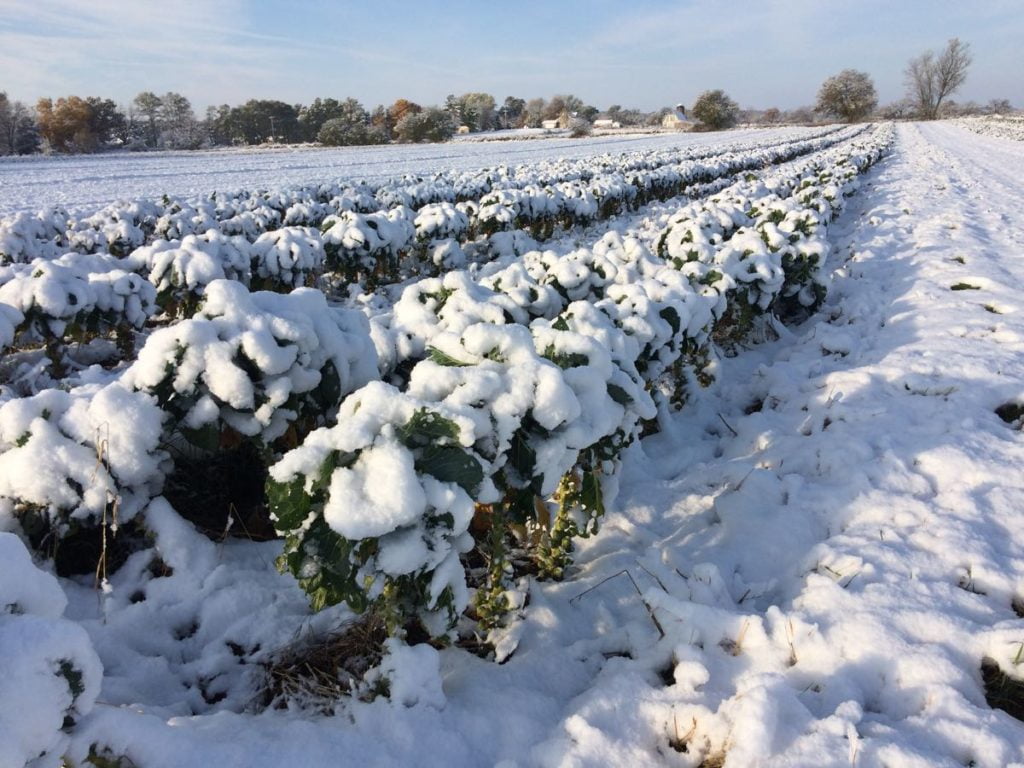
Here are your Brussels sprouts on Tuesday morning. We waited for the snow to (mostly) melt before picking. It’s too much of a mess otherwise, not to mention ridiculously cold. Brussels sprouts are cold-hardy, so we’re not worried about unharvested sprouts left in the field.
Veggie List and Veggie Notes
Week #24 = Final delivery of regular season
October 31/ Nov. 1, 2019 (Thurs/Fri. sites)
– Weekly shares
– EOW/ green
Sweet potatoes, 3 to 3.5 lb
Brussels sprouts, 1 lb
Celeriac, 1 large
Beets, ~2 lb
Carrots, ~2 lb
Koji greens
Bell or frying pepper, 1 or 2
Poblano chiles, 2
Yellow onion
Some sites get broccoli.
Some sites get Romanesco cauliflower.
Sweet potatoes – These are the ‘Beauregard’ variety. Store at room temperature, e.g. on your kitchen counter. Do not cover or wrap in plastic. These will store for a long time.
Brussels sprouts – See last week’s newsletter for cooking information.
Celeriac (knobby, round, bizarre-looking vegetable which smells like celery) – Flavorful celeriac is good raw or cooked. It is excellent in mixed roasted veggies or in soup. It’s especially good in cream soups, alone or mixed with potatoes. Grated raw celeriac is a great starting point for winter salads. Celeriac will store in your refrigerator for months. Cut off chunks as you need them. Peel before using.
Beets – Storage: Cover and refrigerate. Beet roots will store for months. Wash well to remove leaf fragments. For all the cooking methods below, wash and scrub the beets but do not peel. The skins slip off easily once the beets are cooked and cooled.
Cooking beet roots on the stovetop: Slice or quarter, cover with water in a pot, and simmer until tender. This will take from 25 to 45 minutes depending on how large the beet pieces are. Drain.
Roasting beets in oven: Wash beets, but do not peel. On a sheet of aluminum foil, put beets (halved or quartered if large), salt, pepper and a few sprinklings of water. Seal the foil packet, and roast at 400 oF until tender, about 45 minutes to 1 hour. Slip off skins once cool.
Microwave: Slice beets in half and place in a large microwave-proof bowl. Add ¾ inch water and cover with a plate. Microwave on high until tender, about 9-20 minutes, depending on your microwave’s power. Drain and slip off skins.
Uses: Use cooked beets in cold salads, or dress simply with vinaigrette, onions, salt and pepper. Beets are also good tossed with sour cream, minced onion, fresh herbs and walnuts.
Koji greens (head of dark green leaves) – These have some silvering on the tops of the leaves, from rubbing against row cover we used to protect the plants from frost. Just ignore or cut away. Sorry about that.
Koji greens are a lot like Yukina if you know that one; dark green with a nice balance of bitter flavor but not too strong. Like tat soi but with larger, lusher leaves and not so many leaf stalks. Recipes that use mustard greens or bok choy will work with Koji.
Bell or frying pepper – EAT SOON. We protected these plants with row cover outside for as long as we could. They’ve been exposed to cold nights which shortens their storage life. Eat within a few days OR chop and freeze for later. Just toss the frozen pieces into dishes at the end of cooking. We treasure these last few peppers and hope you do too.
Poblano chiles (dark green, shiny, triangular) – EAT SOON, for same reason as the bell peppers. Eat this weekend OR chop and freeze for later. These chiles have low-to-medium heat and great flavor. Most I’ve cooked so far this year were fairly mild, but a few were corkers.
RECIPES
Visit our 2019 Recipe Log or our 2018 Recipe Log or join our Facebook discussion group.
LOCAL THYME/ Comforting Classics
Soy Braised Shrimp with Koji
Nana Maniscalco’s Turkey Barley Soup
Shredded Carrot and Beet Salad with Carrot Ginger Dressing
LOCAL THYME/ Outside the Box Recipes
Vietnamese Noodle Salad with Grilled Beef, Koji and Carrots
Baked Celeriac
Beet Hummus
LOCAL THYME/ Quick & Easy Meal
Black Bean Quinoa Salad with Oranges, Peppers and Roasted Poblanos
????????????
RECIPES FROM LAUREN
BEET & CARROT SLAW WITH KOJI GREENS
Inspired by Bon Appetit
Takes 45 minutes
Serves 4-6
4 garlic cloves, minced
1/2 cup dried currants (or cranberries)
1/4 cup champagne vinegar
2 large (or 1 extra-large) beets, peeled
3-4 large carrots, peeled
2 apples
1 bunch koji greens (reserve the stems for another use), very thinly sliced
1/2 lemon, juiced
1 teaspoon Kosher salt
1/2 teaspoon freshly ground black pepper
1/4 teaspoon red pepper flakes
1/2 cup olive oil
1 cup chopped and toasted almonds
- In a small bowl, combine garlic, currants and vinegar. Let currants plump and garlic mellow in there for at least 20 minutes. It will likely take that long to get your veggies cut up anyhow.
- Cut the beets, carrots and apples into matchsticks and place in a large bowl with the koji greens. Squeeze with lemon and season with salt, pepper, and red pepper flakes. Toss to combine then add the garlic and currant mixture. Drizzle with olive oil and toss several more times to combine. Taste and adjust seasonings as desired.
- Serve with toasted almonds.
.
????????????
.
SWEET POTATO & CELERIAC HASH
Inspired by Bon Appetit
The original recipe that inspired this one didn’t actually call for Brussels Sprouts or poblanos so if you’d rather use them some other way, feel free to leave them out.
Takes 1 hour
Serves 2-4
5 pieces bacon
1 large celeriac, peeled and cut into 3/4-inch dice
1-2 pounds sweet potato, peeled and cut into 3/4-inch dice
1/2 pound Brussels sprouts, halved (quartered if very large)
1/2 teaspoon dried thyme
1 cup chicken broth
1 yellow onion. thinly sliced
2 poblanos, diced
1/2 teaspoon Kosher salt
1/4 teaspoon freshly ground black pepper
2 eggs, optional
Hot sauce, optional
- Preheat oven to 425 degrees.
- Place bacon on a baking sheet and put in oven right away (the oven won’t be preheated yet). Set the oven for 15 minutes and check the bacon then. Add more time if its not done. Once finished, drain grease on paper towel but do not wash pan or get rid of the grease left on the pan– you will use in the next span.
- In a large heavy skillet, combine celeriac, sweet potatoes, and Brussels sprouts. Add thyme and broth. Bring to a boil over medium high heat and cook for 20 minutes stirring occasionally until the vegetables are soft.
- Add softened vegetables to baking sheet you cooked the bacon on. Add onion and poblanos. Sprinkle with salt and pepper. Roast for 40 minutes, stirring after 20 to make sure veggies on the bottom do not burn.
- Serve hash with eggs and hot sauce.
- Cut bacon into pieces and sprinkle over the finished dish. Add more salt or pepper to taste.
.
Week #23, final purple & sun!
- On: October 23, 2019
 0
0
Schedule count down
– This week (October 24/25) is the final delivery for our EOW/purple and Sampler/sun members.
– Next week (Oct. 31/ Nov. 1) will be the final delivery for our Weekly and EOW/green members.
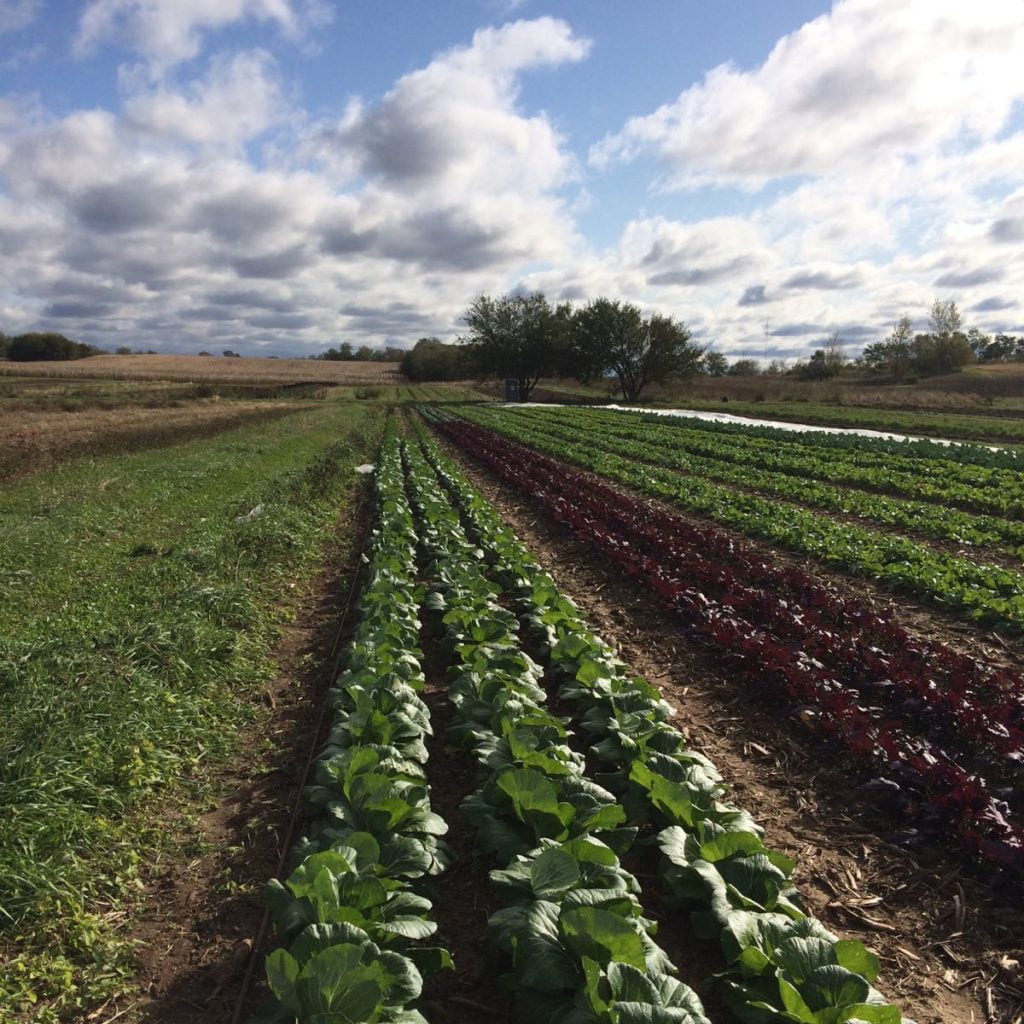
Your bok choy came from this pretty field of greens.
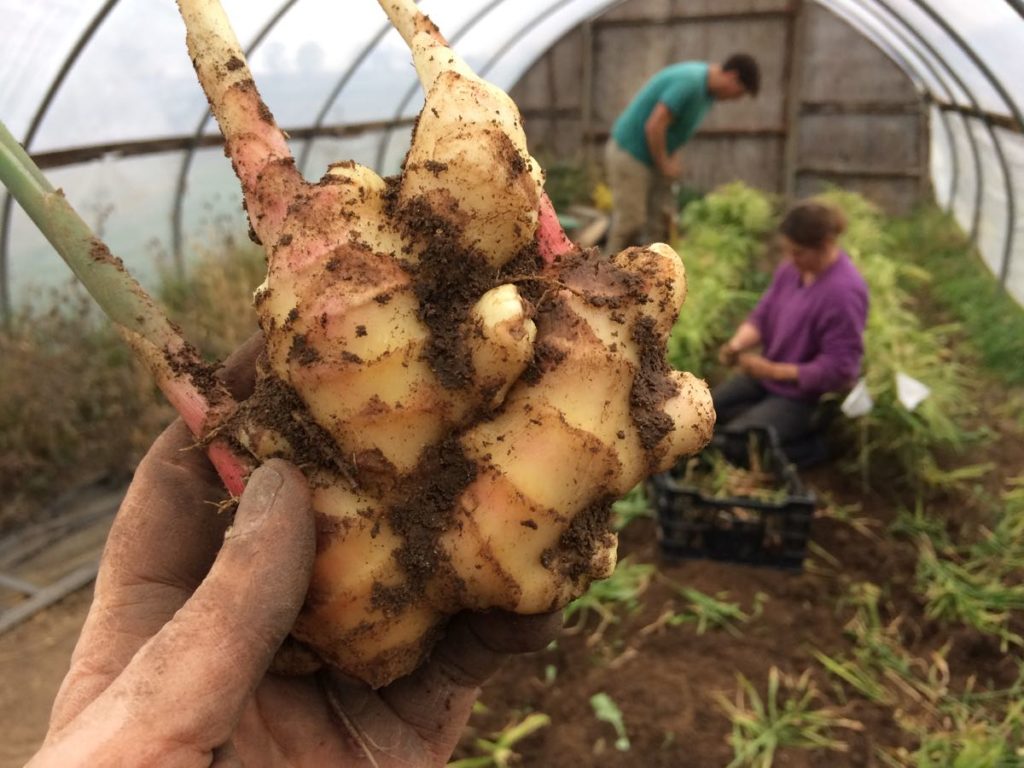
We dug our baby ginger this week. It’s a nice crop this year, enough to deliver a plump piece in every CSA box. In background, Jory and Karen dig the ginger. My job is to divide the harvested rhizomes into portions. It’s a bit of a jigsaw puzzle. I’ll probably divide the root in the photo into three portions. I almost gave up growing ginger because the yields are so low. It simply needs a longer season than we have in Wisconsin. This spring, I tinkered with our planting techniques to get an early start on the season. It worked, so the ginger pieces are bigger this year. We have not yet replicated our spectacular 2015 crop, but we’ll keep trying.
Veggie List and Veggie Notes
Week #23, October 24/25, 2019
– Weekly shares
– EOW/ purple
– Sampler/ sun
We’re packing bok choy with scallions and ginger because they are a great combo for stir-fries or Asian dishes. I plan to make chicken soup, then add bok choy and ginger near the end of the cooking time, then garnish with sliced scallions.
Bok choy
Brussels sprouts, 1 lb
Butternut squash
Yellow potatoes, 3 1/4 lb
Leeks, 1.3 lb
Parsnips, ~1.5 lb
Peppers, a few green bells or fryers
Jalapeno chile, 1
Scallions, 1 bunch
Baby ginger, 1 piece
Each site gets something from this list: broccoli OR cauliflower (white or purple) OR Romanesco broccoli OR maybe something else.
Next week’s box will probably contain Brussels sprouts, beets, carrots, celeriac, onions, Asian greens, sweet potatoes OR winter squash, and more.
Bok choy (large rosette with thick white stems and green leaves) – The bok choy has some minor damage from being covered with row cover on frosty nights. It’s a reasonable trade-off, since we can’t leave it unprotected and risk damage by frost.
This Asian green is good for stir-frying or sautéing or in soup. You can think of the stems and leaves as two separate vegetables. The stems require longer cooking. The leaves will cook almost as quickly as spinach. Storage: Bok choy stores well, so feel free to pull off leaves as you need them, or use the whole head at once. Refrigerate in a plastic bag or other container.
Brussels sprouts – If you are a new CSA member, please approach Brussels sprouts with an open mind. Many of us grew up eating awful, overcooked Brussels sprouts. These Brussels sprouts are completely different.
Here is our method to cook Brussels sprouts: Wash the sprouts and trim the cut ends. Cut an X in the stem end of large sprouts. Cut a single slit in small or medium sprouts. This does two things. It helps the Brussels sprouts cook evenly, plus it allows them to soak up any marinade or dressing. Place sprouts in a pot with one inch of water in the bottom and steam until tender, 7 to 10 minutes. If the sprouts are uneven in size, then set aside the smallest ones and add to the pot after the larger ones have cooked for a few minutes. Don’t overcook them! You can also oven-roast Brussels sprouts.
Here are a few dressing ideas for cooked sprouts:
– Sherry vinegar/olive oil/Dijon mustard/garlic/white wine/salt and pepper. This is our favorite, especially when you combine the Brussels sprouts with slivered peppers and thinly sliced onions. Delicious warm, cold, or at room temperature.
– Balsamic vinegar/olive oil/garlic/salt and pepper
– Lemon juice and zest/melted brown butter/poppy seeds/white wine/garlic/salt
Satina yellow potatoes – These organic potatoes were grown by our friends at Igl Farms. Satina is a good all-purpose potato. Personally, I like these better than Yukon Golds because they’re a little less sweet.
Peppers – Eat these soon! They’ve been exposed to cold nights, which shortens their storage. You’ll get green or green/red peppers. Could be bells, could be frying peppers, could be a mix.
Baby ginger – This is baby ginger, bright white and pink because it hasn’t grown a brown epidermis yet. The ginger sold in stores grows for a long season in warm places like Hawaii. Baby ginger is special because it has the full ginger flavor and spiciness but almost no fibers. That’s why it’s used to make the pickled ginger served with sushi. I asked the crew to wash it lightly to avoid bruising. Expect to do a final wash before using it.
Storage: Eat soon; baby ginger is perishable. Wrap in a damp cloth or paper towel, and keep in the refrigerator in a plastic bag. You can also freeze your ginger, then grate as much as you need from the frozen knob.
RECIPES
Visit our 2019 Recipe Log or our 2018 Recipe Log or join our Facebook discussion group.
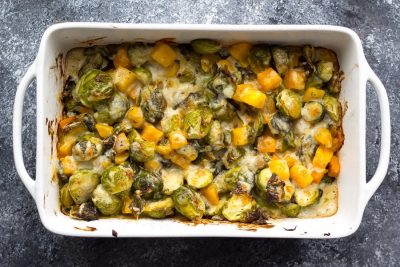
Brussels sprouts gratin
LOCAL THYME/ Comforting Classics
Butternut, Brussels Sprout and Leek Gratin
Creamy Brussels Sprouts and Potato Soup
Red Curry with Chicken, Peppers, Parsnips and Potato
Tofu, Bok Choy and Pepper Fried Rice

Congee with Bok Choy
LOCAL THYME/ Outside the Box Recipes
Butternut Cookies
Sautéed Sesame-Ginger Brussels Sprouts
Pear Parsnip Puree
Bok Choy Congee
LOCAL THYME/ Quick & Easy Meal
Salisbury Steak with Leek, Pepper, and Mushroom Gravy
????



